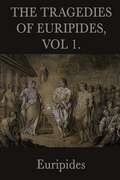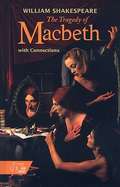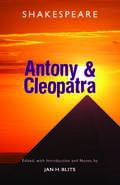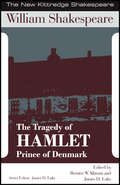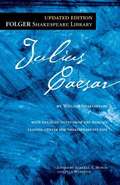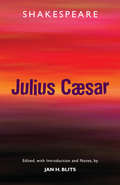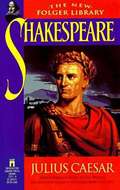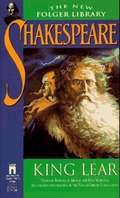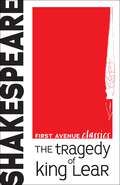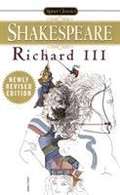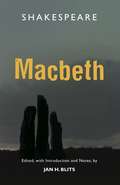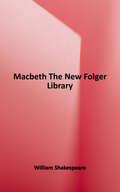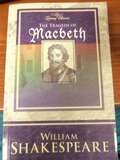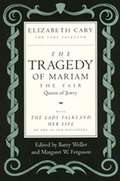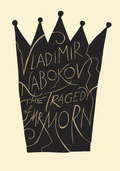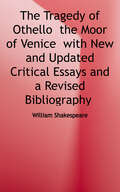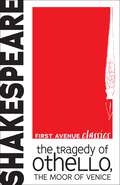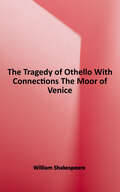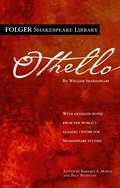- Table View
- List View
The Tragedies of Euripides
by EuripidesIn this volume of Euripides tragedies you will find the pays Hecuba, Orestes, The Phúnician Virgins, Medea, Hippolytus, Alcestis, The Bacchae, The Heracleidae, Iphigenia in Aulis, and Iphigenia in Tauris.
The Tragedies of Shakespeare
by William ShakespeareContains the complete text of such Shakespeare tragedies as Romeo and Juliet, King Lear, and Macbeth.
The Tragedy Of Macbeth: With Connections (Holt McDougal Library, High School With Connections Ser.)
by William Shakespeare Holt StaffThe Holt McDougal Library includes a mix of fiction, nonfiction, drama, poetry, and biographies from a variety of reading levels for use as part of classroom curriculum or independent reading. Students will find selections they love in this extensive collection.
The Tragedy of Antony and Cleopatra (New Kittredge Shakespeare Ser.)
by William Shakespeare"This edition of Antony and Cleopatra gives contemporary readers access to Shakespeare’s meaning as no other edition does. While other editors may provide basic information about the historical setting of the play, Jan Blits makes palpable the shape and feel of the world in which the action unfolds. His annotations citing classical authors reveal a world of possibility that would have been available to earlier generations, that Shakespeare would have taken for granted, and that is lost on readers today. His excellent Introduction frames the drama in terms of questions regarding the relative place of the public and private in the polity’s life, the claims of the universal and the national on the allegiance of citizens, and the meaning of nobility that will be highly provocative for anyone interested in Shakespeare as a political thinker." —Joseph Alulis, North Park University
The Tragedy of Coriolanus (Focus Philosophical Library)
by William ShakespeareIntended for a wide audience, Jan Blits&’s edition of Shakespeare's The Tragedy of Coriolanus differs from other such editions by focusing upon ancient sources to highlight the play&’s setting during the founding of the Roman Republic. In doing so it sheds new light on both the action of the play and the historical and political significance of its setting.
The Tragedy of Hamlet, Prince of Denmark
by William Shakespeare Bernice W. Kliman James H. LakeGeorge Lyman Kittredge's insightful editions of Shakespeare have endured in part because of his eclecticism, his diversity of interests, and his wide-ranging accomplishments, all of which are reflected in the valuable notes in each volume.These new editions have specific emphasis on the performance histories of the plays (on stage and screen).Features of each edition include: The introduction to the original Kittredge Edition Editor's Introduction to the Focus Edition. An overview on major themes of the plays, and sections on the play's performance history on stage and screen. Explanatory Notes. The explanatory notes either expand on Kittredge's superb glosses, or, in the case of plays for which he did not write notes, give the needed explanations for Shakespeare's sometimes demanding language. Performance notes. These appear separately and immediately below the textual footnotes and include discussions of noteworthy stagings of the plays, issues of interpretation, and film and stage choices. How to read the play as Performance Section. A discussion of the written play vs. the play as performed and the various ways in which Shakespeare's words allow the reader to envision the work "off the page." Comprehensive Timeline. Covering major historical events (with brief annotations) as well as relevant details from Shakespeare's life. Some of the Chronologies include time chronologies within the plays. Topics for Discussion and Further Study Section. Critical Issues: Dealing with the text in a larger context and considerations of character, genre, language, and interpretative problems. Performance Issues: Problems and intricacies of staging the play connected to chief issues discussed in the Focus Editions' Introduction. Select Bibliography & Filmography Images from major productions, for comparison and scene study.
The Tragedy of Julius Caesar
by William Shakespeare Barbara A. Mowat Paul WestineThis edition, while retaining many of the features that have always made the Folger Shakespeare so attractive to the general reader, at the same time reflects these current ways of thinking about Shakespeare. For example, modern readers, ac¬tors, and teachers have become interested in the differ¬ences between, on the one hand, the early forms in which Shakespeare's plays were first published and, on the other hand, the forms in which editors through the centuries have presented them. In response to this interest, we have based our edition on what we consider the best early printed version of a particular play (ex¬plaining our rationale in a section called "An Introduc¬tion to This Text") and have marked our changes in the text--unobtrusively, we hope, but in such a way that the curious reader can be aware that a change has been made and can consult the "Textual Notes" to discover what appeared in the early printed version.
The Tragedy of Julius Caesar (Focus Philosophical Library)
by William Shakespeare Jan H. BlitsJan Blits' edition represents something new among editions of Julius Caesar. In addition to textual glosses and explanatory notes focused on the rhetorical, historical, and political contexts of the speeches, it includes a wide array of quotations and citations from writers of classical antiquity chosen to illuminate passages of special pertinence to the Roman world represented in the play. Highlighting Shakespeare's significance as a political thinker, it also demonstrates his deep understanding of Roman antiquity, its competing worldviews, and the demise of its Republic. Intended for a broad readership, the edition also includes a Preface, Introduction, Bibliography, and a topical Index.
The Tragedy of Julius Caesar (The Folger Shakespeare Library)
by William ShakespeareFOLGER Shakespeare Library: the world's leading center for Shakespeare studies. Each edition includes: * Freshly edited text based on the best early printed version of the play * Full explanatory notes conveniently placed on pages facing the text of the play * Scene-by-scene plot summaries * A key to famous lines and phrases * An introduction to reading Shakespeare's language * An essay by a leading Shakespeare scholar providing a modern perspective on the play.
The Tragedy of Julius Caesar with Connections
by William ShakespeareThis famous Shakespearean Tragedy underlines the human dynamics of leadership, it's risks, the development of treachery and the nature of betrayal.
The Tragedy of Julius Caesar: Large Print (First Avenue Classics ™)
by William ShakespeareMarcus Brutus, a Roman politician, considers Emperor Julius Caesar to be a friend, but a senator—Caius Cassius—convinces Brutus that Caesar has too much power. Brutus would rather Rome be a republic than an empire ruled by a tyrant, so he participates in a conspiracy to kill Caesar. Though Brutus believes his actions will benefit Rome, Caesar's murder brings about more bloodshed, including Brutus's own. The play examines friendship and patriotism, the succession of leadership, and the roles of fate and free will. Shakespeare wrote this drama, rooted in Roman history, in 1599; it was published in 1623, after Shakespeare's death. This is an unabridged edition of the tragic play.
The Tragedy of King Lear (First Avenue Classics ™)
by William ShakespeareKing Lear is growing old, and in an effort to preempt an inheritance war, he decides to divide his kingdom between his three daughters while he is still living—dependent on which one loves him the most. Goneril and Regan tell him flattering lies, but the youngest, Cordelia, refuses to answer. Angered, Lear disowns Cordelia. He splits the kingdom between Goneril and Regan, who begin plotting against him. When it becomes clear that the daughters who claimed to love him the most are planning to betray him and that he has banished the one daughter who truly loved him, Lear goes mad and wanders out onto the heath. This is an unabridged version of one of William Shakespeare's most famous tragedies. Versions of the play were first published in 1608 and 1623.
The Tragedy of King Richard the Third
by William ShakespeareWilliam Shakespeare's timeless tragedy follows the bloody path of the "rudely stamped" Richard, Duke of Gloucester, who uses his murderous guile to achieve the throne of England. This revised Signet Classics edition includes unique features such as: An overview of Shakespeare's life, world, and theater; A special introduction to the play by the editor; Selections from the source from which Shakespeare derived Richard III; Dramatic criticism; A comprehensive stage and screen history of notable actors, directors, and productions; Text, notes, and commentaries printed in the clearest, most readable text; And more...
The Tragedy of Macbeth
by William Shakespeare Jan H. BlitsThe fourth in a series of editions of Shakespeare&’s most political and history-soaked plays, this Macbeth offers copious aids to understanding the play not found in any other edition. By attending to the play&’s medieval Scottish setting in a way that rival editors have never matched—when they have even dug beyond the early seventeenth-century context in which it was produced—Jan H. Blits&’s edition richly rewards readers left unsatisfied by &“decodings&” of the play&’s supposed allusions to the politics of early modern England who wish to look deeper. In doing so, it opens the text for readers to encounter, in new ways, the play&’s historical, political, and psychological significance.
The Tragedy of Macbeth
by William ShakespeareWhen three witches tell Macbeth he will one day be king, he works to make sure their prophecy comes true.
The Tragedy of Macbeth (Literary Classics)
by William ShakespeareThis work has been selected by scholars as being culturally important, and is part of the knowledge base of civilization as we know it. This work was reproduced from the original artifact, and remains as true to the original work as possible. Therefore, you will see the original copyright references, library stamps (as most of these works have been housed in our most important libraries around the world), and other notations in the work. <p><p> This work is in the public domain in the United States of America, and possibly other nations. Within the United States, you may freely copy and distribute this work, as no entity (individual or corporate) has a copyright on the body of the work. <p><p> As a reproduction of a historical artifact, this work may contain missing or blurred pages, poor pictures, errant marks, etc. Scholars believe, and we concur, that this work is important enough to be preserved, reproduced, and made generally available to the public. We appreciate your support of the preservation process, and thank you for being an important part of keeping this knowledge alive and relevant.
The Tragedy of Macbeth (The Folger Shakespeare Library)
by William Shakespeare Barbara A. Mowat Paul WerstineThis edition makes the plays and poems of Shakespeare fully understandable for modern readers using uncompromising scholarship. Professors Barbara Mowat and Paul Werstine have produced this New Folger Shakespeare for a new generation of readers.
The Tragedy of Mariam, The Fair Queen of Jewry with The Lady Falkland, Her Life
by Elizabeth Cary Lady Falkland Barry Weller Margaret W. FergusonThe Tragedy of Mariam (1613) is the first original play by a woman to be published in England, and its author is the first English woman writer to be memorialized in a biography, which is included with this edition of the play. With this textually emended and fully annotated edition, the play will now be accessible to all readers. The accompanying biography of Cary further enriches our knowledge of both domestic and religious conflicts in the seventeenth century.
The Tragedy of Mister Morn
by Vladimir Nabokov Thomas Karshan Anastasia TolstoyFor the first time in English, Vladimir Nabokov's earliest major work, written when he was only twenty-four: his only full-length play, introduced by Thomas Karshan and beautifully translated by Karshan and Anastasia Tolstoy. The Tragedy of Mister Morn was written in the winter of 1923-1924, when Nabokov was completely unknown. The five-act play--the story of an incognito king whose love for the wife of a banished revolutionary brings on the chaos the king has fought to prevent--was never published in Nabokov's lifetime and lay in manuscript until it appeared in a Russian literary journal in 1997. It is an astonishingly precocious work, in exquisite verse, touching for the first time on what would become this great writer's major themes: intense sexual desire and jealousy, the elusiveness of happiness, the power of the imagination, and the eternal battle between truth and fantasy. The play is Nabokov's major response to the Russian Revolution, which he had lived through, but it approaches the events of 1917 above all through the prism of Shakespearean tragedy.
The Tragedy of Othello the Moor of Venice: With New and Updated Critical Essays and a Revised Bibliography (Signet Classics Ser.)
by William ShakespeareThe Signet Classics edition of William Shakespeare's Othello, a disturbing exploration of jealousy and wrath. Tragedy takes hold as the cunning and hateful Iago drives the heroic Moor of Venice first to suspicion, then to homicidal rage against his love Desdemona, in one of the Bard's darkest plays. This revised Signet Classics edition includes unique features such as-. An overview of Shakespeare's life, world, and theater -A special introduction to the play by the editor, Alvin Kernan - Selections from Giraldi Cinthio's Hecatommithi, the source from which Shakespeare drived Othello - Dramatic criticism from Samuel Taylor Coleridge, Maynard Mack, and others - A comprehensive stage and screen history of notable actors, directors, and productions - Text, notes, and commentaries printed in the clearest, most readable text - And more...
The Tragedy of Othello, the Moor of Venice: Edited, With Notes (classic Reprint) (First Avenue Classics ™)
by William ShakespeareOthello, a general in the Venetian army, has married the lovely Desdemona, and Roderigo is not at all happy. He was hoping to woo Desdemona for himself. Roderigo's jealousy is all Iago, Roderigo's sneaky friend, needs, as he has his own reasons to be angry with Othello. By weaving an intricate web of deceit, infidelity, and envy, Iago is able to plant false suspicions and lead people to commit crimes that will destroy the relationships dearest to them. This is an unabridged version of one of William Shakespeare's most famous tragedies, first published in England in 1622.
The Tragedy of Othello: The Moor of Venice (Bantam Classic)
by William Shakespeare David Scott KastanThough this great tragedy of unsurpassed intensity and emotion is played out against Renaissance splendor, its story of the doomed marriage of a Venetian senator's daughter, Desdemona, to a Moorish general, Othello, is especially relevant to modern audiences. The differences in race and background create an initial tension that allows the horrifyingly envious villain Iago methodically to promote the "green-eyed monster" jealousy, until, in one of the most deeply moving scenes in theatrical history, the noble Moor destroys the woman he loves only to discover too late that she was innocent. Each Edition Includes: - Comprehensive explanatory notes - Vivid introductions and the most up-to-date scholarship - Clear, modernized spelling and punctuation, enabling contemporary readers to understand the Elizabethan English - Completely updated, detailed bibliographies and performance histories - An interpretive essay on film adaptations of the play, along with an extensive filmography From the Paperback edition.
The Tragedy of Othello: The Moor of Venice (The Folger Shakespeare Library)
by William Shakespeare Barbara A. Mowat Paul WerstineDesigned to make Shakespeare's great plays available to all readers, the New Folger Library edition of Shakespeare's plays provides accurate texts in modern spelling and punctuation, as well as scene-by-scene action summaries, full explanatory notes, many pictures clarifying Shakespeare's language, and notes recording all significant departures from the early printed versions. Each play is prefaced by a brief introduction, by a guide to reading Shakespeare's language, and by accounts of his life and theater. Each play is followed by an annotated list of further readings and by a "Modern Perspective" written by an expert on that particular play.
